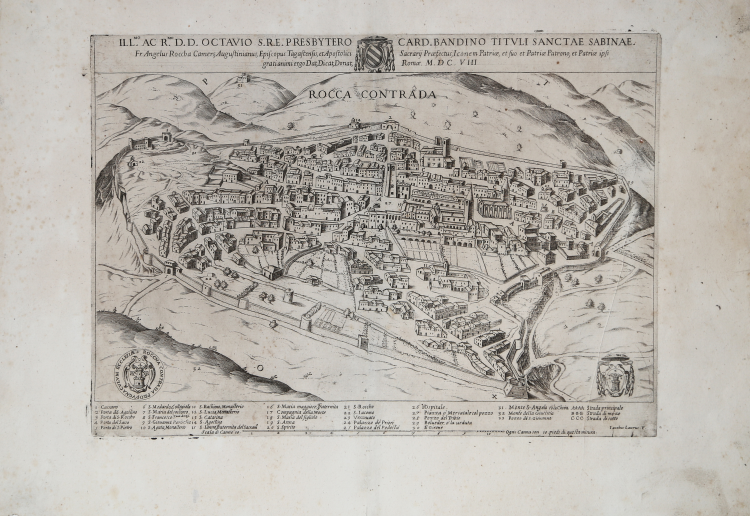




| Reference: | S39313 |
| Author | Giacomo LAURO |
| Year: | 1608 |
| Zone: | Arcevia |
| Measures: | 410 x 290 mm |



| Reference: | S39313 |
| Author | Giacomo LAURO |
| Year: | 1608 |
| Zone: | Arcevia |
| Measures: | 410 x 290 mm |
Prototype of the bird's eye view of the city, commissioned by Angelo Rocca, designed by Ercole Ramazzani and engraved by Giacomo Lauro in 1594. The work is dedicated to Cardinal Rastucci. Bottom left, the coat of arms of Rocca Contrada, bottom right the coat of arms of Angelo Rocca.
Example of the second state, dated 1608, with the coat of arms of Cardinal Bandini at the top, the new dedicatee.
“Nel 1594 l’autorevole Angelo Rocca (1545-1620), agostiniano vescovo di Tagaste, biblista e bibliofilo, nativo di Rocca Contrada (oggi Arcevia), commissiona per motivi celebrativi un suo rilievo al pittore Ercole Ramazzani, arceviese, allievo di Lorenzo Lotto” (cfr. Giorgio Mangani, Geopolitica del paesaggio, p. 71).
Rocca Contrada, today called Arcevia, a very small town which in fifteenth and sixteenth centuries experienced a brief period of political and military importance. It is probable, however, that the city would not have had the cartographic attention that it had, if one of its most authoritative sons, the Augustinian scholar Angelo Rocca (Rocca Contrada, 1545 - Rome 1620), philologist, biblical scholar and, from 1605, bishop of Tagaste, great collector of books that were at the origin of the Biblioteca Angelica of Rome, which takes its name from him, had not commissioned a drawing of the city to the local painter Ercole Ramazzani (Rocca Contrada, 1530-1598).
Ramazzani, arceviese, worked between Marche and Umbria in the style of the mannerism of the Zuccari with a particular landscape sensibility that evidently betrays also an activity cartographic and vedutistica, to the epoch natural complement of the pictorial activity. His was in fact the sketch of the relief of Rocca Contrada commissioned by Rocca and executed in 1594.
A new state of the engraving of 1608 was instead dedicated to Ottavio Bandini, who became cardinal protector of Rocca Contrada when he was Legate of the Marca, succeeding Rusticucci in 1603, after his death.
A very rare work, whose only known exemplar of the first state (1594) is the one preserved in the Biblioteca Angelica in Rome, founded by Angelo Rocca himself.
Literature
Anselmo Anselmi, La pianta panoramica di Roccacontrada, oggi Arcevia, disegnata da Ercole Ramazzani nel 1594, in “La Bibliofilía” Vol. 8, No. 10/11 (Gennaio-Febbraio 1907), pp. 366-372.
|
Engraver, printer and print publisher. Active in Rome from 1583. 17 March 1598 he applied for and was granted a ten-year papal privilege for an unspecified number of unnamed religious prints.
Lauro’s earliest dated prints are of 1585, and carry the address of C. Duchetti. He also worked for Panzera in 1589. From 1590 he tried to establish himself as a publisher of his own work. He acquired and restored old plates, published copies of such classic prints as Marcantonio’ St.Paul preaching . He accepted commissions, as the map of Rocca Contrada, 1594.
He probably acquired plates from Jacob Matham which he published in 1598. His Antiquae Urbis Splendor was published in parts from 1612. In the volumes issued in 1614 and 1615 Lauro refers to having worked on it for 28 years which would mean that he began it about 1586. Important connections with Poland; he specialized in images of saints.
|
|
Engraver, printer and print publisher. Active in Rome from 1583. 17 March 1598 he applied for and was granted a ten-year papal privilege for an unspecified number of unnamed religious prints.
Lauro’s earliest dated prints are of 1585, and carry the address of C. Duchetti. He also worked for Panzera in 1589. From 1590 he tried to establish himself as a publisher of his own work. He acquired and restored old plates, published copies of such classic prints as Marcantonio’ St.Paul preaching . He accepted commissions, as the map of Rocca Contrada, 1594.
He probably acquired plates from Jacob Matham which he published in 1598. His Antiquae Urbis Splendor was published in parts from 1612. In the volumes issued in 1614 and 1615 Lauro refers to having worked on it for 28 years which would mean that he began it about 1586. Important connections with Poland; he specialized in images of saints.
|